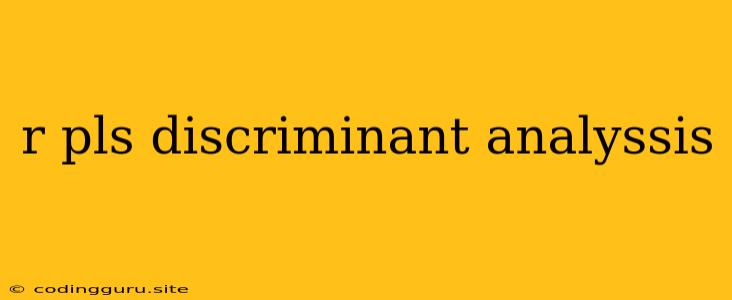Understanding Discriminant Analysis: A Guide to R
Discriminant analysis is a powerful statistical technique used to classify observations into predefined groups based on a set of predictor variables. It's a valuable tool in fields like marketing, finance, and healthcare for tasks like customer segmentation, credit risk assessment, and disease diagnosis.
What is Discriminant Analysis?
In simple terms, discriminant analysis aims to find the best linear combination of predictor variables that separates different groups. Think of it as drawing a line (or a hyperplane in higher dimensions) that divides your data into distinct clusters. The algorithm identifies this line (or hyperplane) by maximizing the difference between the means of the groups while minimizing the within-group variance.
Why Use R for Discriminant Analysis?
R is an open-source statistical programming language known for its comprehensive libraries and packages, making it an ideal environment for implementing discriminant analysis. Libraries like MASS and caret offer functions specifically designed for performing various discriminant analysis techniques, including:
-
Linear Discriminant Analysis (LDA): Assumes that the data follows a multivariate normal distribution with equal covariance matrices for all groups. This method is preferred when the groups are well-separated and the data meets these assumptions.
-
Quadratic Discriminant Analysis (QDA): Allows for different covariance matrices across groups, making it more flexible than LDA. It's useful when the data exhibits non-linear relationships or when the groups have unequal variances.
Steps Involved in Discriminant Analysis Using R
- Load Necessary Libraries: Start by loading the required libraries:
library(MASS)
library(caret)
-
Prepare Your Data: Ensure your data is in a suitable format, typically a dataframe. The data should include predictor variables and a categorical variable representing the groups you want to classify.
-
Fit the Model: Use the lda() function for LDA or qda() function for QDA, specifying the predictor variables and the grouping variable:
model <- lda(grouping_variable ~ predictor1 + predictor2 + ..., data = your_data)
# or
model <- qda(grouping_variable ~ predictor1 + predictor2 + ..., data = your_data)
- Predict New Observations: Once the model is fitted, you can predict the group membership for new observations:
predictions <- predict(model, newdata = new_observations)$class
Understanding the Output:
The output of the discriminant analysis will typically include:
-
Coefficients: The weights assigned to each predictor variable in the linear combination used for classification. These coefficients can be interpreted to understand the importance of each variable in distinguishing between groups.
-
Prior Probabilities: The proportion of observations belonging to each group in your training data. These probabilities are used by the model to make predictions.
-
Discriminant Functions: These functions are used to calculate the discriminant scores for each observation, based on the coefficients and the values of the predictor variables. The higher the score for a particular group, the more likely the observation belongs to that group.
Interpreting the Results:
-
Visualize the Discriminant Functions: Use scatterplots or other graphical techniques to visualize the separation of groups based on the discriminant functions.
-
Evaluate Model Performance: Use metrics like accuracy, precision, recall, and F1-score to assess how well the model performs in classifying new observations.
Examples:
Let's consider a simple example where we want to classify customers based on their age and income into two groups: "high-spending" and "low-spending."
# Load the data
data <- read.csv("customer_data.csv")
# Fit an LDA model
model <- lda(spending_group ~ age + income, data = data)
# Predict the spending group for a new customer
new_customer <- data.frame(age = 35, income = 70000)
prediction <- predict(model, newdata = new_customer)$class
# Print the prediction
print(prediction)
Tips for Successful Discriminant Analysis:
-
Data Preparation: Ensure your data is clean and free from outliers. Consider standardizing or scaling your predictor variables to avoid bias from different units of measurement.
-
Variable Selection: Select relevant predictor variables that are likely to contribute to group separation. You can use techniques like feature selection to identify important variables.
-
Model Evaluation: Use appropriate metrics and cross-validation techniques to evaluate the performance of your discriminant analysis model and avoid overfitting.
Conclusion:
Discriminant analysis is a powerful tool for classifying observations into predefined groups based on predictor variables. R provides a rich set of libraries and functions to implement various discriminant analysis techniques, making it a preferred choice for researchers and data analysts. By understanding the principles of discriminant analysis and utilizing R's capabilities, you can effectively build predictive models for various applications.
